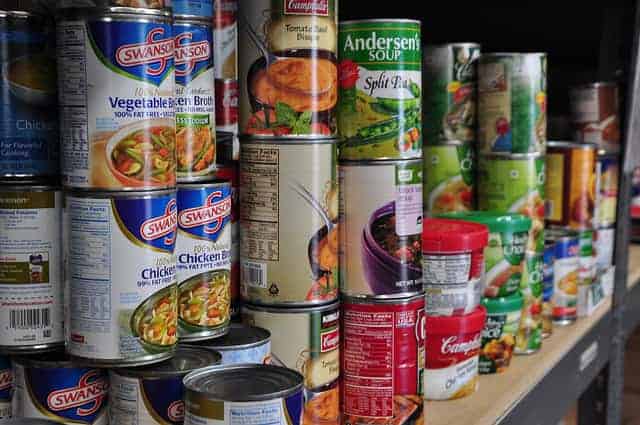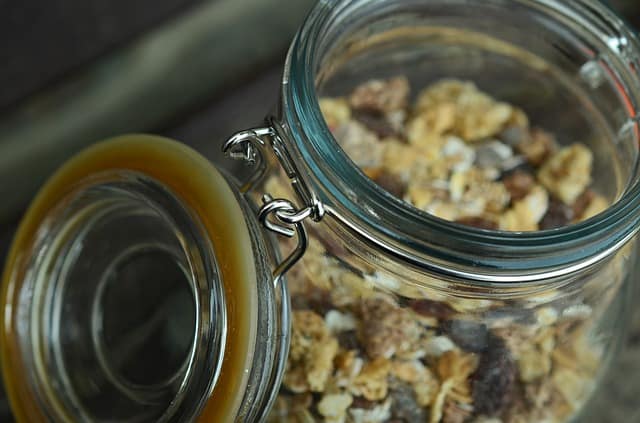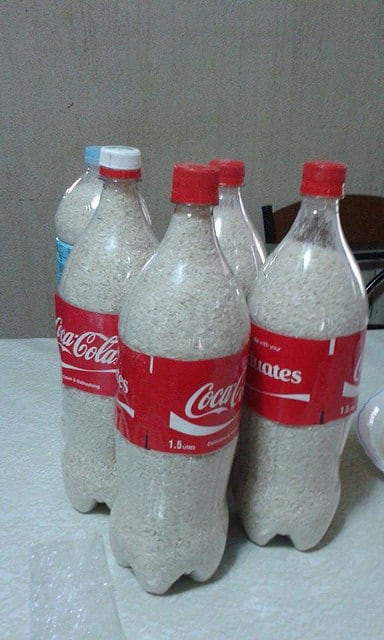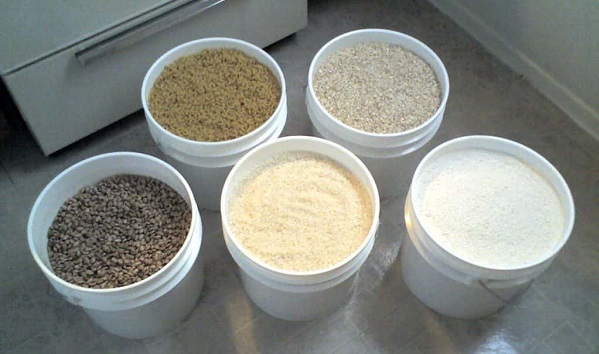The subject of which containers are best for long-term food storage is controversial. The only thing that people seem to agree on is that food storage containers matter!
If you are choosing storage containers for your survival food, the last thing you want is to find your emergency food has gone bad because of improper storage containers!
Here’s the thing: We each use our survival food stores differently.
- Some people will load buckets with food and then forget about them for the next 25 years or until a disaster occurs.
- Others slowly rotate through their food stores.
- Yet others quickly rotate through their food stores or work with smaller quantities because of budget constraints.
To help you choose which storage containers are best for your survival food stockpile, I will cover all the main options and the pros/cons of each.
The 5 Enemies of Long Term Food Storage

Before we get into the options for food storage containers, I want to go over the “enemies” of food storage. These 5 elements will destroy food. No food storage container will completely protect against heat, but the best options will protect against the other 4 elements.
- Heat
- Humidity
- Oxygen
- Light
- Pests
Option #1) The Original Packaging
Storing them in their original packaging is the easiest option for foods like crackers and boxed dinners. So long as you are mindful of the expiration dates and rotating them, they shouldn’t go bad. However, these packages weren’t meant to survive disasters like hurricanes and earthquakes.
Consider, for example, what would happen during a hurricane that tears through your home. Your shelves would go toppling down, crashing onto your foods. Your crackers, cookies, etc., would be smashed open and exposed to the rain.
Another issue with plastic packaging is that rodents can easily gnaw through it. No matter how clean you think your home is, it is still susceptible to rodents!
Consider that earthquakes typically bring about hygiene disasters and rodent infestations commonly occur in the aftermath.
Do you really want to worry about defending your emergency food from critters after such a disaster?
Read about mouse and rat-proof food storage options.
Pros:
- Easy
- No special containers or equipment required
Cons:
- Not safe from rodents, insects, and other animals
- Insect eggs inside may start to populate
- Packaging can easily be broken/destroyed
Verdict: Okay for people just starting with disaster preparedness.
Option #2) Glass Jars

If you buy foods like grains in bulk, one of the easiest ways to store them is in glass jars. You can even use the old jars from foods like pickles for storing these bulk foods. The first obvious problem with glass jars is that they will break during an emergency.
I’ve talked to some preppers who store their emergency foods in glass jars but reinforce their shelves. I’m not a good handyman and don’t want to pay someone to make me a disaster-proof shelving system. Instead, it is easier for me to avoid glass jars. A simple solution (though not wholly disaster-proof) is this:
Run a 1″ x 4″ board across the front of your shelves. This will keep the glass jars from falling onto the floor during a disaster like an earthquake.
Also, remember to secure your cabinet doors so things don’t fly out during an earthquake!
My family does use glass jars for our home pressure canning. For example, we’ve got a decent garden going and make preserves, pickled vegetables, and pressure-canned veggies. These jars are mostly stored in our basement.
They could still be destroyed by debris crashing down on them. Still, the basement is generally the safest room when it comes to natural disasters.
Pros:
- Cheap and easy
- Rodent proof
- Can see contents within for easy rotation
Cons:
- Glass can easily break
- Hard to get an air-tight seal
Verdict: An okay solution for people not living in earthquake zones, and when shelves are reinforced, you will be rotating through your food stores reasonably quickly. You’ll need to add oxygen absorbers to the jars before closing them for longer-term storage.
Read more about oxygen absorbers for food storage.
Option #3) Plastic Containers

A cheap, easy way to store your bulk foods (grains, dry beans, etc.) is to put them in clean, emptied plastic bottles, such as from soda. Put a piece of plastic wrap over the top and then put the bottle cap on.
Stored like this, your bulk foods should be (relatively) safe against insects, rodents, and flooding. Best of all, you don’t have to worry about the containers shattering during an earthquake.
This method isn’t perfect because the plastic can eventually leach into the foods (I doubt you’ll care about BPA during a disaster, though!).
The plastic is also slightly porous, so it won’t regulate humidity well. Rodents can also chew through plastic bottles.
Pros:
- Cheap and easy
- Shatter-proof
- Can see contents for easy rotation
- Decent protection against insects and rodents
Cons:
- Doesn’t fully protect against humidity and oxygen
- Plastic may leach into foods
Verdict: Good for your 30-day supply of emergency foods as long as you rotate through it every 6 months. Not acceptable for long-term survival food storage.
Option #4) Food-Grade Buckets

5 gallon buckets (Amazon link) are great for storing large amounts of food. In theory, you can dump dry staples into the buckets and be done. I’d recommend getting a gamma lid; these form air-tight seals that prevent insects from entering the food. Some people put oxygen absorber packets into the buckets to remove oxygen, which helps the food last longer.
The downside is that storing food in buckets does not protect against insects’ eggs already in the food. You’ll have to take steps to kill insect eggs, such as microwaving or freezing the food first. Also, even gamma lids aren’t completely air-tight, so eventually, oxygen will cause spoilage. Because gallon buckets hold so much food, it can be tricky to rotate through them.
Pros:
- Good protection against light, humidity, and air
- Holds lots of food
- Protects against rodents
- Not likely to break during a disaster
Cons:
- Have to buy the buckets or go looking for free ones
- It can be difficult to rotate through the food
- Lids are hard to open
- Insect infestations can occur
- Must be made from food-safe plastic
Verdict: This is a decent option for semi-long-term food storage that you will rotate through within a year or two.
Option #5) Mylar Pouches with Oxygen Absorbers
Mylar is a metallic-looking material that is impervious to light and gas. Once sealed, it will not let air through. Adding an oxygen absorber packet to the Mylar bag before sealing will create an oxygen-free environment. Dry foods can last for years or decades like this.
Read more about storing food in Mylar bags.
The problem with Mylar pouches is that their seals can easily break if handled roughly, and rodents can easily chew through them.
Pros:
- Air-tight seal
- Good for storing large quantities of food
- Can rotate through the food easily
Cons:
- Can be easily damaged
- Doesn’t protect against rodents or large animals
- Need to purchase the pouches and sealing equipment
Verdict: Good for long-term food storage, but you need to keep the pouches somewhere safe from damage.
Where to buy?
We like an American company, Wallaby; they provide excellent products at a reasonable price and have a great range.
Option #6) Mylar Pouches inside a Bucket
Most preppers agree this is the best option for long-term food storage. The vacuum-sealed Mylar bags protect against oxygen and humidity. The bucket protects against physical damage while providing an extra layer of oxygen/humidity control (as long as you aren’t opening the buckets).
The great thing about this method is that after you’ve sealed your buckets, you can forget about them. The food will be good for upwards of 25 years!
This isn’t good if you plan on accessing the food before then. Once you open the bucket and pouch, you’ll have to reseal them all over again.
Pros:
- Food stays fresh for upwards of 25 years
- Protection against insects, rodents, and animals
- Protections against rough handling and the elements
Cons:
- Requires special equipment
- Has a higher learning curve to be done correctly
- Not good for food you want to rotate or access
Verdict: Good for storing survival foods for very long periods, assuming you won’t be opening the buckets or pouches.
Important Note: Protection Against Insects
One of the biggest mistakes my wife and I made when we were just getting started with food prepping was failing to protect against insects.
We just poured our bulk foods into jars and plastic bottles and figured we’d be fine. When we looked at the containers a few months later, they were filled with moths and larvae!
I have no problem eating insects, but eating their droppings can spell a health risk.
Even if you store your emergency foods in air-tight, sealed containers, insects can still contaminate them. This is because the insect eggs are already there when you buy the food!
It is normal and safe for some insect eggs to be in bulk foods. Usually, the eggs don’t have time to hatch before you eat the food. However, those few insect eggs can become an infestation when storing your food for a long time.
Read about how to prevent insects in your food storage here.
How do you store your food? Any tips you can share? Let us know over at the Primal Survivor Facebook group!


If you think plastic or even cans will stop bug infestations, wait until you meet the larder beetle (“larder” means pantry, or cellar where food is stored) . They can and will eat thru both and lay their eggs in your food. I’ve yet to find an exterminator that can get rid of them. About the only thing they cannot chew through is glass. Plastic buckets and mylar bags won’t stop them.
My husband and I are preparing for our retirement. I already can produce in jars and have most of my life. What I’m not sure about is long term storing of flour, rice, beans and spices for long periods. We plan to move to the TX coast. Also meats other than smoking everything.
Currently I use a deep freeze but need options due to seasonal flooding, hurricanes and tornadoes. Also power failures. We are planning on using a cargo container for our food storage.
For long-term storage of dry goods, you really can’t beat Mylar bags + Oxygen Absorbers. Put these in buckets with lids to protect against rodents and physical damage. Fatty/oily foods like jerky and even brown rice need to stay cool, so those are tricky. Spices and other expensive items I keep in the freezer since these don’t take up too much space.
how do I know what size of oxygen absorbers to use for a 5 gallon bucket of rice and beans? Thank you
There is info here: https://www.primalsurvivor.net/oxygen-absorbers/
For my long term food storage I have been buying large and medium packages of food, (sugar, flour, beans, coffee, etc.) not bulk, placing the unopened packages in Mylar bags with oxygen packs, then placing the bags in plastic containers. Is there a problem with doing it this way? I’m slowly adding to my supply and It’s helped economically.
This should be fine with paper packaging but not sealed plastic packaging. It’s best to remove food from its packaging first. Otherwise the oxygen absorbers might not be able to absorb the oxygen around the food. You’ll also need to use more oxygen absorbers because of all the extra air space in the food packaging.
You could simply slit or puncture the original plastic packaging just before placing them into the mylar bags with oxygen absorbers. This should ensure the oxygen, in the original plastic packaging, is absorbed.
I DID transfer beans and rice from freezer to vacumn sealed jars then wondered about the condensation issue. What is solution
? I considered 1. Emptying jars 2. Spreading beans or rice on multiple baking trays and placing in oven to dry
3. Then after cooling storing in clean dry jars for vacumn sealing
Will that work and if so how long and what oven temperature?
Both were done within last week
Just let the beans come to room temperature before putting them into any other container. No need to go overboard and dry them further (unless you really want to). Ideally, you don’t do it on a humid day.
So many Survival Web Sites – so little Information!! Until I stumbled across your site. Oh, my goodness, this is the best information I’ve found after hours and hours of reading and learning (sort of). Do not know whether you’ve been told, but your information is excellent and I found you in a search for mylar bags of all things. Thank you so much for all the tips and great ideas and answers.
Glad you found it useful 🙂
I want to get signed up on your site. I am learning and wanting to prep.
I read that putting diamatacious earth in the dry food will kill any insects. Any thoughts on that?
Diamatacious earth is often used to kill insects in large-scale grain storage (as in large amounts of grains stored in sacks), so I guess it would work. However, I don’t think it is the best solution for home food storage and have honestly never heard of anyone using it for such. You are better off using Mylar + oxygen absorbers. Or, if you use other storage methods, just get used to the idea of eating some insects — weevils and moths are actually pretty healthy and safe to eat if you cook the food 🙂
Will putting food in the freezer for several days introduce moisture to the food that could cause mold?
Correct! After removing food from the freezer you need to let it come to room temperature or moisture will form. I talk about that a bit in this post –https://www.primalsurvivor.net/bugs-weevils-moths-food-storage/
Hello,
when storing in Mylar with Oxygen absorber & buckets, do you think it is necessary to microwave or freeze the grains against larvae?
Yes it is still necessary, check out this post which goes in-depth on mylar bags.
If you think mice can’t chew through plastic, you haven’t met the mice we have around our farm! I’m trying to find a source of SQUARE metal lidded boxes to put food storage in. There are some out there, but they are usually not big enough. I could use small trash cans, but since they are round they don’t store on a shelf as efficiently as a square would. Why is this so hard?
Hi Connie – yes I had a look for some metal boxes and they are surprisingly hard to source. Is there anything you could re-purpose from around the farm? Do any readers have any suggestions?
old metal file boxes for storing food
look into contractors JOB BOXes. they are made of steel and are available in various sizes. some as big as a car and others the size of an old trunk.
Good suggestion. I’ve seen some nice stainless steel rainwater barrels but they tend to be very pricy.
35 gallon trash cans with lids should be considered because they may be weather and rodent proof.
Bobbito, when I was growing up my father stored our long-term food supply in metal trash cans in the basement. If you can find one with a tight lid that is.
You can do a pretty good job f rodent proofing by using a couple layers of galvanized mesh over something like cement board. In homes I use copper mesh and steel wool to fill gaps and holes and the spray expanding foam. So far not one rodent has bothered trying to eat through all of it. Once you know how it’s pretty easy and not too pricey. Rodent damage is crazy expensive. We had major wiring in house and car ruined. We almost had a bad flood from a rodent that gnawed through an ABS pipe.
Find an old chest freezer. They are square and should fit your needs. We use one for our feed grain out in the barn and it keeps the mice out of that. I also toss a couple of cotton balls with essential mint oil behind the freezer to help.
Just make sure to have the Freon drained bc it will eventually leak otherwise
Ammunition boxes are rectangular metal, lock-down, air/water-tight, reusable containers that are used by millions world-wide for long-term to permanent storage. You can get them used at flea markets and new/used at Army/Navy Surplus stores.
How would I store flour in them?
The old man and I are considering downsizing to a RV, 5th wheel or travel trailer, and setting up on a small piece of land out in the boonies. We also want to put up a steel building for storing things like a generator, food, etc. for SHTF situations. Any suggestions to make it work better for storing food. and other things?
Hi Deanna – the main consideration with out buildings is the fluctuation in temperature which can play havoc with your food preps. Have a look at this article which goes more in-depth: https://www.primalsurvivor.net/storing-emergency-food-stockpile/
I just sent you an email – wanted to send you some Vacuum sealed containers. For free. No catch.
Justin
Thank you so much I have been studying this for a while I just can’t get it right
That is so kind of you to be so giving to others.
That’s all I wanted to say.
Currently, I’m using Mint-X trash bags to store a 20-pound bag of pinto beans (uncooked). These are only sold at Home Depot. The bag is in a clean steel ash can, and covered w a steel lid. This keeps rodents away from my clothing and papers, but is it safe for food? Will the beans absorb the chemical mint smell?
What if I add a plastic or Mylar layer between the original paper bean bag and the Mint-X bag.
The beans will most likley absorb the chemicals and their smell. If you are going to add a Mylar bag, then (IMO) you might as well just seeal them in Mylar with oxygen absorbers. The beans would easily last over a decade this way.
Yes please